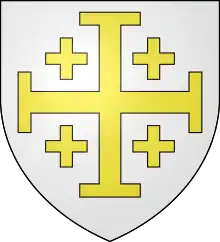| House of Flanders | |
|---|---|
 Arms of the County of Flanders | |
| Country | |
| Founded | 863 |
| Founder | Baldwin Iron Arm |
| Titles | |
| Estate(s) | Flanders, Hainaut, Constantinople, Boulogne |
| Dissolution | 10 February 1280 |
| Cadet branches |
|
The House of Flanders, also called the Baldwins (Latin: Balduini, French: Baudouinides), was a medieval ruling family of Frankish origin that was founded by Baldwin Iron Arm, son-in-law of Charles the Bald. The House of Flanders was the first dynasty to transform a county function of the Carolingian Empire into a hereditary fiefdom, the County of Flanders, falling under West Francia, created by the Treaty of Verdun in 843.[1]
From 1051, the House of Flanders also reigned over the County of Hainaut, with Baldwin I of Hainaut. In 1119, on the death of Baldwin VII, the family had a series of setbacks, but in 1191, the family recovered the title of Count of Flanders with Baldwin VIII (Baldwin V of Hainaut).
The dynasty established the Latin Empire of Constantinople during the Fourth Crusade, and it also briefly ruled the County of Namur (1188–1212). The House of Flanders became extinct in 1280 with the death of Margaret II.
A cadet branch, the House of Boulogne, ruled over the County of Boulogne. Members of this house joined the First Crusade, established the Kingdom of Jerusalem, and produced its first kings.
Genealogy
 Baldwin Iron Arm, Count of Flanders († 879)
Baldwin Iron Arm, Count of Flanders († 879)
-
 Baldwin II the Bald, Count of Flanders († 918)
Baldwin II the Bald, Count of Flanders († 918)
 Arnulf I the Great, Count of Flanders († 965)
Arnulf I the Great, Count of Flanders († 965)
- Elftrude, born circa 932, married in 964 to
.png.webp) Siegfried, Count of Guînes († 965)
Siegfried, Count of Guînes († 965) - Hildegarde (934 † 990), married in 943 to
 Dirk II, Count of Holland (930 † 988)
Dirk II, Count of Holland (930 † 988) - Egbert (937 † 953)
- Liutgarde (938 † 964), married in 950 to Wichmann IV, Count of Hamaland and Ghent.
-
 Baldwin III, Count of Flanders († 962)
Baldwin III, Count of Flanders († 962)
-
 Arnulf II, Count of Flanders († 988)
Arnulf II, Count of Flanders († 988)
- Mathilda († 995 or before)
-
 Baldwin IV the Bearded (v.980 † 1035), Count of Flanders († 1035)
Baldwin IV the Bearded (v.980 † 1035), Count of Flanders († 1035)
 Baldwin V of Lille, Count of Flanders († 1067)
Baldwin V of Lille, Count of Flanders († 1067)

 Baldwin VI the Good, (1030 - 1070), Count of Flanders and of Hainaut
Baldwin VI the Good, (1030 - 1070), Count of Flanders and of Hainaut

 Arnulf III of Flanders (1055 † 1071), Count of Flanders and Hainaut
Arnulf III of Flanders (1055 † 1071), Count of Flanders and Hainaut-
 Baldwin II of Hainaut (1056 † 1098), Count of Hainaut
Baldwin II of Hainaut (1056 † 1098), Count of Hainaut
-
 Baldwin III of Hainaut (1088 † 1120), Count of Hainaut
Baldwin III of Hainaut (1088 † 1120), Count of Hainaut
-
 Baldwin IV the Builder (1108 † 1171), Count of Hainaut
Baldwin IV the Builder (1108 † 1171), Count of Hainaut
- Agnes of Hainaut, married
 Ralph I, Lord of Coucy
Ralph I, Lord of Coucy -
 Baldwin V of Hainaut (1150 † 1195), Count of Hainaut
Baldwin V of Hainaut (1150 † 1195), Count of Hainaut
- Isabella of Hainault (°1170- †1190), married
 Philip II of France
Philip II of France 

 Baldwin VI of Hainaut (°1171- †1205), Count of Flanders and Hainaut, Latin Emperor of Constantinople
Baldwin VI of Hainaut (°1171- †1205), Count of Flanders and Hainaut, Latin Emperor of Constantinople

 Joan (1199-1200 † 1244), Countess of Flanders and of Hainaut
Joan (1199-1200 † 1244), Countess of Flanders and of Hainaut-

 Margaret II (c. 1202 † 1280), Countess of Flanders and of Hainaut
Margaret II (c. 1202 † 1280), Countess of Flanders and of Hainaut
- Yolanda (°1175- †1219), married
 Peter II of Courtenay, Latin Emperor of Constantinople
Peter II of Courtenay, Latin Emperor of Constantinople  Philip the Noble, Marquis of Namur (°1175- †1212)
Philip the Noble, Marquis of Namur (°1175- †1212) Henry (°1176- †1216), Latin Emperor of Constantinople
Henry (°1176- †1216), Latin Emperor of Constantinople- Sybille (°1179- †1217), married to
.svg.png.webp) Guichard IV, Sire of Beaujeu
Guichard IV, Sire of Beaujeu -
 Eustace (†1217), regent of the Kingdom of Thessalonica
Eustace (†1217), regent of the Kingdom of Thessalonica
- Isabella of Hainault (°1170- †1190), married
- Agnes of Hainaut, married
-
-
- Matilda (1032 - 1083), married in 1053 to
 William the Conqueror
William the Conqueror -
 Robert the Frisian, (1033 - 1093), Count of Flanders from 1071 to 1093
Robert the Frisian, (1033 - 1093), Count of Flanders from 1071 to 1093
 Robert II, Count of Flanders from 1093 to 1111
Robert II, Count of Flanders from 1093 to 1111
 Baldwin VII (1093-1119), Count of Flanders
Baldwin VII (1093-1119), Count of Flanders- Guillaume (1094-1109)
- Philip (1095-) (died young)
- Adela of Flanders († 1115), married firstly
 Canute IV of Denmark. Married secondly
Canute IV of Denmark. Married secondly  Roger Borsa, Duke of Apulia.
Roger Borsa, Duke of Apulia.
-
 Charles I, Count of Flanders (1084 – 1127)
Charles I, Count of Flanders (1084 – 1127)
-
- Gertrude (1080 - † 1117), married to Henry III († 1095) Count of Louvain and Brussels, then in 1096 to Theodoric II, Duke of Lorraine († 1115).
- Philip of Loo, whose illegitimate son William of Ypres was a claimant to the county of Flanders.
- Ogive, abbess of Mesen.
- Judith of Flanders, Countess of Northumbria (1037 † 1094), married in 1058 to Tostig Godwinson († 1066), Earl of Northumbria, then in 1071 to Welf I, Duke of Bavaria († 1101)
-
- Elftrude, born circa 932, married in 964 to
-
 Adelolf († 933), Count of Boulogne
Adelolf († 933), Count of Boulogne
-
 Arnulf II († 971), Count of Boulogne
Arnulf II († 971), Count of Boulogne
-
 Arnulf III († 990), Count of Boulogne
Arnulf III († 990), Count of Boulogne
 Baldwin II († 1025), Count of Boulogne
Baldwin II († 1025), Count of Boulogne
-
 Eustace I (v. 995 † 1049), Count of Boulogne
Eustace I (v. 995 † 1049), Count of Boulogne
 Eustace II († 1087), Count of Boulogne
Eustace II († 1087), Count of Boulogne
 Eustace III, Count of Boulogne (1056 † 1125)
Eustace III, Count of Boulogne (1056 † 1125)
- Matilda I, Countess of Boulogne (1105 † 1152), married in 1125 to Stephen of England
- Godfrey of Bouillon (1058 † 1099), Duke of Lower Lorraine, a leader of the First Crusade and "Advocate of the Holy Sepulchre"
-
 Baldwin I of Jerusalem (1065 † 1118), accompanied his brother to the Holy Land, became Count of Edessa and then King of Jerusalem
Baldwin I of Jerusalem (1065 † 1118), accompanied his brother to the Holy Land, became Count of Edessa and then King of Jerusalem
- Godfrey († 1095), Bishop of Paris
- Lambert II, Count of Lens († 1054)
- Gerberge († 1049), married Frederick, Duke of Lower Lorraine (1003 † 1065)
-
- Arnulf IV, Count of Ternois
-
-
-
Family tree

Arms






References
- ↑ Le Glay, Edward (1814-1894) Auteur du texte (1843). Histoire des comtes de Flandre jusqu'à l'avènement de la maison de Bourgogne. 2 / par Edward Le Glay,...
{{cite book}}: CS1 maint: numeric names: authors list (link)